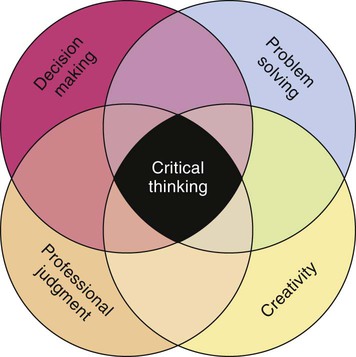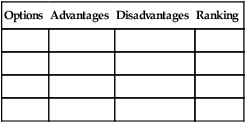• Apply a decision-making format to list options to solve a problem, identify the pros and cons of each option, rank the options, and select the best option. • Evaluate the effect of faulty information gathering on a decision-making experience. • Analyze the decision-making style of a nurse leader/manager. • Critique resources on the Internet that focus on critical thinking, problem solving, and decision making. Problem solving and decision making are essential skills for effective nursing practice. Carol Huston (2008) identified “expert decision-making skills” as one of the eight vital leadership competencies for 2020. These processes not only are involved in managing and delivering care but also are essential for engaging in planned change. Myriad technologic, social, political, and economic changes have dramatically affected health care and nursing. Increased patient acuity, shorter hospital stays, shortage of healthcare providers, increased technology, greater emphasis on quality and patient safety, and the continuing shift from inpatient to ambulatory and home health care are some of the changes that require nurses to make rational and valid decisions. Moreover, increased diversity in patient populations, employment settings, and types of healthcare providers demands efficient and effective decision making and problem solving. More emphasis is now placed on involving patients in decision making and problem solving and using multidisciplinary teams to achieve results. Effective problem solving and decision making are predicated on an individual’s ability to think critically. Although critical thinking has been defined in numerous ways, Scriven and Paul (2007) refer to it as “ the intellectually disciplined process of actively and skillfully conceptualizing, applying, analyzing, synthesizing, and/or evaluating information gathered from, or generated by, observation, experience, reflection, reasoning, or communication, as a guide to belief and action.” Effective critical thinkers are self-aware individuals who strive to improve their reasoning abilities by asking “why,” “what,” or “how.” A nurse who questions why a patient is restless is thinking critically. Compare the analytical abilities of a nurse who assumes a patient is restless because of anxiety related to an upcoming procedure with those of a nurse who asks if there could be another explanation and proceeds to investigate possible causes. It is important for nurse leaders and managers to assess staff members’ ability to think critically and enhance their knowledge and skills through staff-development programs, coaching, and role modeling. Establishing a positive and motivating work environment can enhance attitudes and dispositions to think critically. The model depicted in Figure 6-1 demonstrates the relationship among related concepts such as professional judgment, decision making, problem solving, creativity, and critical thinking. Sound clinical judgment requires critical or reflective thinking. Critical thinking is the concept that interweaves and links the others. An individual, through the application of critical-thinking skills, engages in problem solving and decision making in an environment that can promote or inhibit these skills. It is the nurse leader’s and manager’s task to model these skills and promote them in others. The phases of the decision-making process include defining objectives, generating options, identifying advantages and disadvantages of each option, ranking the options, selecting the option most likely to achieve the predefined objectives, implementing the option, and evaluating the result. Box 6-1 contains a form that can be used to complete these steps. If the situation is subjective, non-routine, and unstructured or if outcomes are unknown or unpredictable, the nurse leader and manager may need to take a different approach. In this case, a descriptive or behavioral approach is required. More information will need to be gathered to address the situation effectively. Creativity, experience, and group process are useful in dealing with the unknown. In the business world, Camillus described complex problems that are difficult to describe or resolve as “wicked” (as cited in Huston, 2008). This term is apt in describing the issues that nurse leaders face. In these situations, it is especially important for nurse leaders to seek expert opinion and involve key stakeholders. Numerous factors affect individuals and groups in the decision-making process. Tanner (2006) conducted an extensive review of the literature to develop a Clinical Judgment Model. Out of the research, she concluded that five principle factors influence decision making. (See the Literature Perspective below.) Certain personality factors, such as self-esteem and self-confidence, affect whether one is willing to take risks in solving problems or making decisions. Keynes (2008) asserts that individuals may be influenced based on social pressures. For example, are you inclined to make decisions to satisfy people to whom you are accountable or from whom you feel social pressure?
Making Decisions and Solving Problems
Introduction
Definitions

Decision Making
Decision Models
Factors Affecting Decision Making
![]()
Stay updated, free articles. Join our Telegram channel

Full access? Get Clinical Tree


Nurse Key
Fastest Nurse Insight Engine
Get Clinical Tree app for offline access


